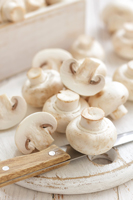The mild taste of Africa-grown rooibos—pronounced Roy-boss—(Aspalathus linearis) has made it a very popular ingredient in various herbal-tea blends. The name means “red bush;” a flowering shrub that grows in the Cedarberg mountain region in South Africa’s western cape, north of Cape Town.
Rooibos is an erect shrub that grows about five feet high. It sports reddish-brown stems and bright-green needlelike leaves. Since it’s a legume, the root contains nodules inhabited by nitrogen-fixing bacteria. This characteristic enables the plant to survive the nutrient-poor, acidic soils of the Cedarberg region.
Red and Green Tea
The leaves and twigs of rooibos are commercially harvested between January and March—summertime in South Africa. They’re cut into small pieces, fermented in a process that is essentially an oxidation, and then sun-dried. Since the fermentation turns the leaves a red-orange color, the end product is used to make a red tea.
An alternative treatment of the leaves and twigs does not include the fermentation or oxidation step, and produces what’s referred to as green rooibos. The tea made from unfermented rooibos has a yellow-tan color and possesses a milder taste. The red tea delivers a stronger flavor described as sweet and fruity. Both are available either plain or flavored.
Green rooibos is often preferred because it contains a considerably higher level of antioxidants. The fermentation step decreases the antioxidant activity of the tea, possibly due to the 25 percent loss of polyphenolics
during the process.
Nutritional Value
In spite of many claims to the contrary, rooibos is not a good source of vitamin C and provides very little of most minerals. A 200-milliliter cup of the red tea boasts less than 2 percent of most of the minerals. Exceptions to this are fluoride and copper, which appear in significant amounts.
In addition to its high level of polyphenolic antioxidants, another reason that rooibos has become a popular health beverage is that the mild-tasting tea is totally caffeine-free. This gives it a distinct advantage over regular green and black teas made from Camellia sinensis. Furthermore, it also possesses a low level of tannins, thus bypassing the bitter, astringent taste experienced with many other teas.
The low tannin content of rooibos is an advantage for persons with digestive problems who have difficulty with tannin-rich beverages. Tannins bind iron and therefore reduce the absorption of non-heme iron. This can be significant for those with marginal iron intake. Some teas, like black and peppermint, may inhibit iron as much as 80 to 90 percent.
Antispasmodic Effect
Possibly due to its high flavonoid content, rooibos is reported to have antispasmodic properties and is commonly used in South Africa to treat babies suffering from colic and stomach cramps. South Africans also use the tea for calming intestinal spasms and digestive upsets in adults. Because it is rich in polyphenolic antioxidants, some claim that this tea should protect one against cardiovascular disease. It’s been found to be of some help in preventing diabetic vascular complications.
Possible Cancer Protection
Animal studies have shown that rooibos has potent antimutagenic (to keep from mutating) activity, as well as immune-boosting and cancer-protective action. Human studies are limited.
Rooibos enhances the body’s ability to inhibit skin tumors. Its flavonoids can protect against unwanted genetic damage to cells. An extract of the tea has been shown to augment antibody production with the generation of interleukin-10. At present, scientists are evaluating the effect of rooibos tea in providing protection against liver and colon cancer. It can activate an enzyme system known for its ability to clear the body of cancer-causing agents.
Other Health Properties
Rooibos tea is commonly used for respiratory disorders. The tea is rich in flavonoids that provide selective bronchodilator (opens the bronchial tract) effects and anti-inflammatory activity. Some have claimed that rooibos can also help with allergies, eczema, and other ailments. But many of the health claims have not been verified by scientific research. A Japanese study did establish that patients with dermatitis showed a significant decrease in itching when using rooibos.
The antioxidants of rooibos tea may be useful in helping to prevent changes in the aging brain. Experiments have revealed that it can prevent age-related accumulation of lipid oxidation products in several regions of the brains of rats. If this can also be shown to be true for humans, rooibos could prove useful as an antiaging agent.
Common Usage
Rooibos can be served either as a hot beverage or as an ice tea, and acts as the basis for soups, sauces, fruit drinks, hand creams, and body lotions. No adverse effects have been reported. Rooibos provides a beverage that both tastes good and is useful against fighting respiratory ailments and gastrointestinal disorders. More studies are needed to validate its uses and properties.
Winston J. Craig, Ph.D., R.D., is professor of nutrition at Andrews University, Berrien Springs, Michigan.



